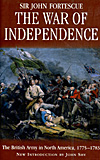 Greenhill, 2001, £ 18.99, ISBN: 1-85367-452-4, 263 pgs.
Greenhill, 2001, £ 18.99, ISBN: 1-85367-452-4, 263 pgs.
Sir John Forescue is known for his 13-volume History of the British Army from the 17th Century to 1870. This reprint is the third volume that was originally published in 1903 and revised in 1911. Obviously, it does not include up to the minute research, but is based on period correspondence and a century of analysis.
This book is patently pro-British, and for those of us used to two-sided analysis of battles and wars, wears a bit thin. A product of its times, you might say, for the sun still never sets on the British Empire. The Army can do no wrong, although one wonders how they lost the American War of Independence to the ragtag colonists in the first place. The answer, and I suppose fortunately for us U.S. folks, revolves around cross-ocean interloping by Lord George Germaine.
In Fortescue's mind, if only Germaine had let the British generals in America conduct the war, all would have been right with the world. Germaine becomes the whipping boy, scapegoat, and all things wrong with the government in the author's mind, and you'll hear about it again and again.
Next on the list of what went wrong are the American loyalists, who receive vitriolic ambushes throughout the book about their loyalty, competence, and intentions. Even after re-reading portions of this book, I'm still not sure whether Fortescue condemns the loyalists more so or less so than the rebels they're fighting.
And yet, if you can get past this 19th Century attitude, you'll find a wealth of information about the "other side", and that's worth the price of admission. Seeing the war through British eyes with a pro-British spin offsets the usually overexposed US viewpoint.
For example, Fortescue gives credit to Washington for saving the American Revolution on that Christmas Day in 1776 when he crossed the Delaware River and attacked Trenton, NJ. The plan was bold and skillfully executed. Yet Fortescue also blames Col. von Rahl for failing to build redoubts and blames Col. von Dunop for hightailing it to Princeton instead of marching on Trenton.
The Battle of Princeton two weeks later is counted as a British victory, for relatively few soldiers were lost to the rebels while Washington was forced north to Morristown, NJ.
- "In a word, the moral effect of the past campaign was in great measure cancelled, and the whole of the work, excepting the capture of New York, required to be done again. The situation was extremely embarrassing. The operations had been based on the assistance of the loyalists, but the loyalists, as might have been anticipated, had not fulfilled the requirements expected of them." [pg 56-57]
Cornwallis takes a little heat for running back to New Brunswick, but he gets more heat many pages later for Yorktown.
Of particular note is the back channel strategy sessions held by the British generals and with Germaine. It's a bit of a primer on how to be inefficient as well as offering a glimpse on the difficulty and challenges of putting down a rebellion covering a wide area.
Overall, American Revolution enthusiasts will enjoy reading the British perspective on the war. There are enough facts and figures to give you an idea of battles, strengths, and so on. It's a tight little book deserving a spot on your American Revolution shelf.
Back to List of Book Reviews: Horse and Musket
Back to Master Book Review List
Back to Master Magazine List
© Copyright 2001 by Coalition Web, Inc.
This article appears in MagWeb (Magazine Web) on the Internet World Wide Web.
Other military history articles and gaming articles are available at http://www.magweb.com